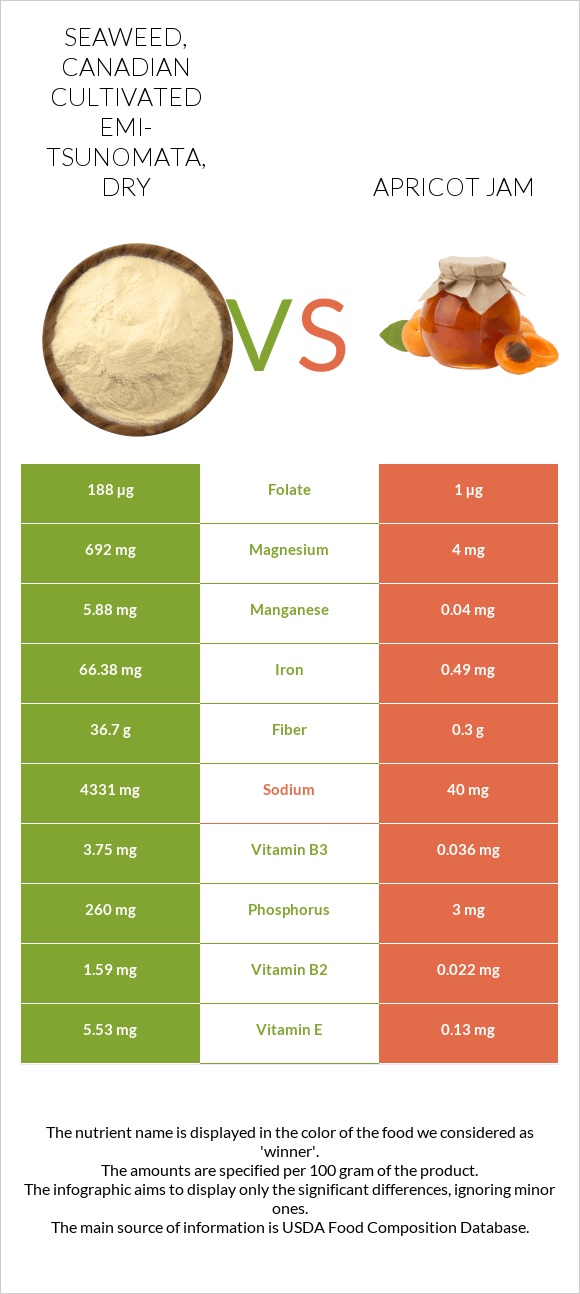Seaweed, Canadian Cultivated EMI-TSUNOMATA, dry vs. Apricot jam — In-Depth Nutrition Comparison
Compare
How are seaweed, Canadian Cultivated EMI-TSUNOMATA, dry and apricot jam different?
- Apricot jam contains less iron, manganese, magnesium, vitamin A, fiber, vitamin B2, vitamin B12, potassium, and folate than seaweed, Canadian Cultivated EMI-TSUNOMATA, dry.
- Seaweed, Canadian Cultivated EMI-TSUNOMATA, dry covers your daily need for iron, 824% more than apricot jam.
- Apricot jam contains less sodium.
Seaweed, Canadian Cultivated EMI-TSUNOMATA, dry and Jams and preserves, apricot types were used in this article.
Infographic

Infographic link
Mineral Comparison
Mineral comparison score is based on the number of minerals by which one or the other food is richer. The "coverage" charts below show how much of the daily needs can be covered by 300 grams of the food.
| Contains more MagnesiumMagnesium | +17200% |
| Contains more CalciumCalcium | +1395% |
| Contains more PotassiumPotassium | +3723.4% |
| Contains more IronIron | +13446.9% |
| Contains more CopperCopper | +370% |
| Contains more ZincZinc | +4116.7% |
| Contains more PhosphorusPhosphorus | +8566.7% |
| Contains more ManganeseManganese | +14600% |
| Contains less SodiumSodium | -99.1% |
Vitamin Comparison
Vitamin comparison score is based on the number of vitamins by which one or the other food is richer. The "coverage" charts below show how much of the daily needs can be covered by 300 grams of the food.
| Contains more Vitamin CVitamin C | +229.5% |
| Contains more Vitamin AVitamin A | +3960% |
| Contains more Vitamin EVitamin E | +4153.8% |
| Contains more Vitamin DVitamin D | +∞% |
| Contains more Vitamin B1Vitamin B1 | +∞% |
| Contains more Vitamin B2Vitamin B2 | +7127.3% |
| Contains more Vitamin B3Vitamin B3 | +10316.7% |
| Contains more Vitamin B6Vitamin B6 | +1050% |
| Contains more Vitamin B12Vitamin B12 | +∞% |
| Contains more FolateFolate | +18700% |
All nutrients comparison - raw data values
| Nutrient |  |
 |
DV% diff. |
| Iron | 66.38mg | 0.49mg | 824% |
| Manganese | 5.88mg | 0.04mg | 254% |
| Sodium | 4331mg | 40mg | 187% |
| Magnesium | 692mg | 4mg | 164% |
| Fiber | 36.7g | 0.3g | 146% |
| Vitamin B2 | 1.59mg | 0.022mg | 121% |
| Vitamin B12 | 2.25µg | 0µg | 94% |
| Potassium | 2944mg | 77mg | 84% |
| Folate | 188µg | 1µg | 47% |
| Vitamin A | 406µg | 10µg | 44% |
| Copper | 0.47mg | 0.1mg | 41% |
| Vitamin B1 | 0.48mg | 0mg | 40% |
| Phosphorus | 260mg | 3mg | 37% |
| Vitamin E | 5.53mg | 0.13mg | 36% |
| Protein | 15.34g | 0.7g | 29% |
| Calcium | 299mg | 20mg | 28% |
| Vitamin B3 | 3.75mg | 0.036mg | 23% |
| Vitamin C | 29mg | 8.8mg | 22% |
| Zinc | 2.53mg | 0.06mg | 22% |
| Vitamin D | 126 IU | 0 IU | 16% |
| Vitamin D | 3.1µg | 0µg | 16% |
| Vitamin B6 | 0.23mg | 0.02mg | 16% |
| Cholesterol | 33mg | 0mg | 11% |
| Carbs | 46.24g | 64.4g | 6% |
| Polyunsaturated fat | 0.75g | 0g | 5% |
| Selenium | 2µg | 4% | |
| Fats | 1.39g | 0.2g | 2% |
| Saturated fat | 0.45g | 0.01g | 2% |
| Calories | 259kcal | 242kcal | 1% |
| Net carbs | 9.54g | 64.1g | N/A |
| Sugar | 43.4g | N/A | |
| Vitamin B5 | 0.02mg | 0% | |
| Choline | 0.4mg | 0% | |
| Monounsaturated fat | 0.11g | 0g | 0% |
| Tryptophan | 0.162mg | 0% | |
| Threonine | 0.583mg | 0% | |
| Isoleucine | 0.563mg | 0% | |
| Leucine | 0.903mg | 0% | |
| Lysine | 0.751mg | 0% | |
| Methionine | 0.254mg | 0% | |
| Phenylalanine | 0.807mg | 0% | |
| Valine | 0.664mg | 0% | |
| Histidine | 0.229mg | 0% |
Macronutrient Comparison
Macronutrient breakdown side-by-side comparison
Protein:
15.34 g
Fats:
1.39 g
Carbs:
46.24 g
Water:
14 g
Other:
23.03 g
Protein:
0.7 g
Fats:
0.2 g
Carbs:
64.4 g
Water:
34.5 g
Other:
0.2 g
| Contains more ProteinProtein | +2091.4% |
| Contains more FatsFats | +595% |
| Contains more OtherOther | +11415% |
| Contains more CarbsCarbs | +39.3% |
| Contains more WaterWater | +146.4% |
Fat Type Comparison
Fat type breakdown side-by-side comparison
Saturated fat:
Sat. Fat
0.45 g
Monounsaturated fat:
Mono. Fat
0.11 g
Polyunsaturated fat:
Poly. Fat
0.75 g
Saturated fat:
Sat. Fat
0.01 g
Monounsaturated fat:
Mono. Fat
0 g
Polyunsaturated fat:
Poly. Fat
0 g
| Contains more Mono. FatMonounsaturated fat | +∞% |
| Contains more Poly. FatPolyunsaturated fat | +∞% |
| Contains less Sat. FatSaturated fat | -97.8% |